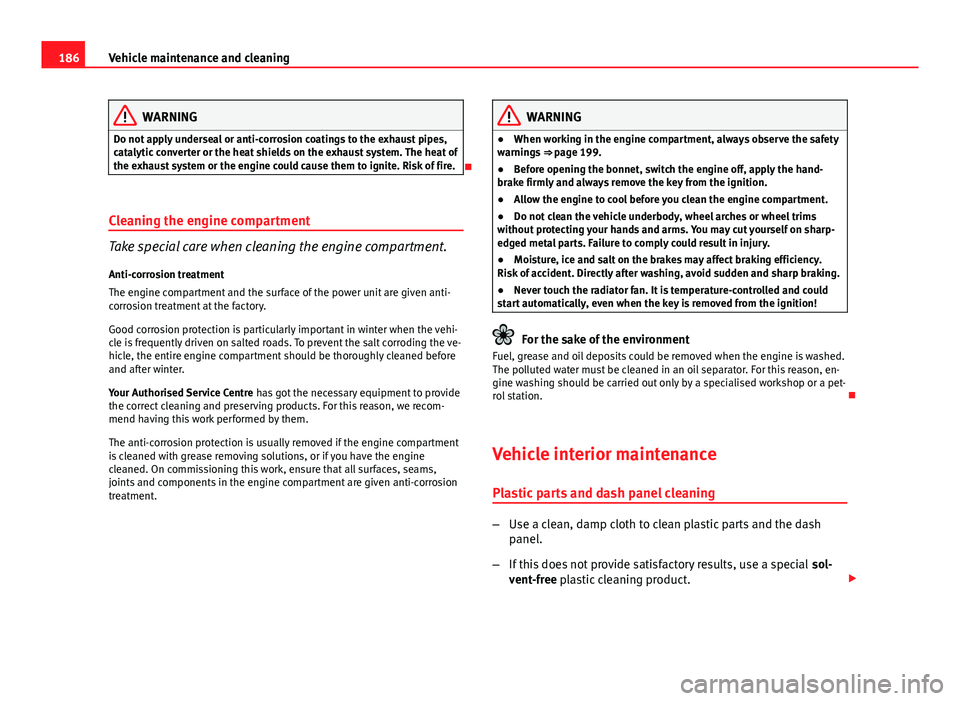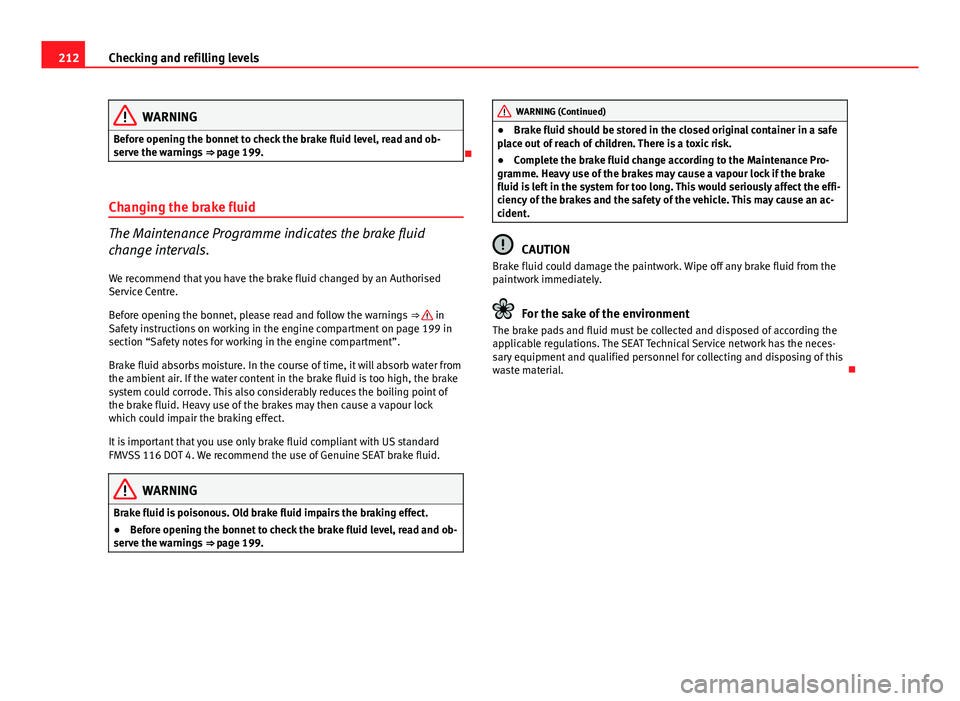2011 Seat Ibiza ST brakes
[x] Cancel search: brakesPage 188 of 280

186Vehicle maintenance and cleaning
WARNING
Do not apply underseal or anti-corrosion coatings to the exhaust pipes,
catalytic converter or the heat shields on the exhaust system. The heat of
the exhaust system or the engine could cause them to ignite. Risk of fire.
Cleaning the engine compartment
Take special care when cleaning the engine compartment.
Anti-corrosion treatment
The engine compartment and the surface of the power unit are given anti-
corrosion treatment at the factory.
Good corrosion protection is particularly important in winter when the vehi-
cle is frequently driven on salted roads. To prevent the salt corroding the ve-
hicle, the entire engine compartment should be thoroughly cleaned before
and after winter.
Your Authorised Service Centre has got the necessary equipment to provide
the correct cleaning and preserving products. For this reason, we recom-
mend having this work performed by them.
The anti-corrosion protection is usually removed if the engine compartment
is cleaned with grease removing solutions, or if you have the engine
cleaned. On commissioning this work, ensure that all surfaces, seams,
joints and components in the engine compartment are given anti-corrosion
treatment.
WARNING
● When working in the engine compartment, always observe the safety
warnings ⇒ page 199.
● Before opening the bonnet, switch the engine off, apply the hand-
brake firmly and always remove the key from the ignition.
● Allow the engine to cool before you clean the engine compartment.
● Do not clean the vehicle underbody, wheel arches or wheel trims
without protecting your hands and arms. You may cut yourself on sharp-
edged metal parts. Failure to comply could result in injury.
● Moisture, ice and salt on the brakes may affect braking efficiency.
Risk of accident. Directly after washing, avoid sudden and sharp braking.
● Never touch the radiator fan. It is temperature-controlled and could
start automatically, even when the key is removed from the ignition!
For the sake of the environment
Fuel, grease and oil deposits could be removed when the engine is washed.
The polluted water must be cleaned in an oil separator. For this reason, en-
gine washing should be carried out only by a specialised workshop or a pet-
rol station.
Vehicle interior maintenance Plastic parts and dash panel cleaning
– Use a clean, damp cloth to clean plastic parts and the dash
panel.
– If this does not provide satisfactory results, use a special sol-
vent-free plastic cleaning product.
Page 214 of 280

212Checking and refilling levels
WARNING
Before opening the bonnet to check the brake fluid level, read and ob-
serve the warnings ⇒ page 199.
Changing the brake fluid
The Maintenance Programme indicates the brake fluid
change intervals. We recommend that you have the brake fluid changed by an Authorised
Service Centre.
Before opening the bonnet, please read and follow the warnings ⇒
in
Safety instructions on working in the engine compartment on page 199 in
section “Safety notes for working in the engine compartment”.
Brake fluid absorbs moisture. In the course of time, it will absorb water from
the ambient air. If the water content in the brake fluid is too high, the brake
system could corrode. This also considerably reduces the boiling point of
the brake fluid. Heavy use of the brakes may then cause a vapour lock
which could impair the braking effect.
It is important that you use only brake fluid compliant with US standard
FMVSS 116 DOT 4. We recommend the use of Genuine SEAT brake fluid.
WARNING
Brake fluid is poisonous. Old brake fluid impairs the braking effect.
● Before opening the bonnet to check the brake fluid level, read and ob-
serve the warnings ⇒ page 199.
WARNING (Continued)
● Brake fluid should be stored in the closed original container in a safe
place out of reach of children. There is a toxic risk.
● Complete the brake fluid change according to the Maintenance Pro-
gramme. Heavy use of the brakes may cause a vapour lock if the brake
fluid is left in the system for too long. This would seriously affect the effi-
ciency of the brakes and the safety of the vehicle. This may cause an ac-
cident.
CAUTION
Brake fluid could damage the paintwork. Wipe off any brake fluid from the
paintwork immediately.
For the sake of the environment
The brake pads and fluid must be collected and disposed of according the
applicable regulations. The SEAT Technical Service network has the neces-
sary equipment and qualified personnel for collecting and disposing of this
waste material.
Page 220 of 280

218Checking and refilling levels
195/65 R15 91T
This contains the following information: Tyre width in mm
Height/width ratio in %
Tyre construction: Radial
Rim diameter in inches
Load rating code
Speed rating
The tyres could also have the following information:
● A direction of rotation symbol
● “Reinforced” denotes heavy-duty tyres.
The manufacturing date is also indicated on the tyre sidewall (possibly only
on the inner side of the wheel).
“DOT ... 1103 ...” means, for example, that the tyre was produced in the
11th week of 2003.
We recommend that work on tyres and wheels be carried out by an Author-
ised Service Centre. They are familiar with the procedure and have the nec-
essary special tools and spare parts as well as the proper facilities for dis-
posing of the old tyres.
Any Authorised Service Centre has full information on the technical require-
ments when installing or changing tyres, wheels or wheel trims. 195
65
R
15
91
T
WARNING
● We recommend that you use only wheels and tyres which have been
approved by SEAT for your model. Failure to do so could impair vehicle
handling. Risk of accident.
● Avoid running the vehicle on tyres that are more than 6 years old. If
you have no alternative, you should drive slowly and with extra care at all
times.
● Never use old tyres or those with an unknown history of use.
● If wheel trims are retrofitted, you must ensure that the flow of air to
the brakes is not restricted. This could cause them to overheat.
● All four wheels must be fitted with radial tyres of the same type, size
(rolling circumference) and the same tread pattern.
For the sake of the environment
Old tyres must be disposed of according to the laws in the country con-
cerned.
Note
● For technical reasons, it is not generally possible to use the wheels from
other vehicles. This can also apply to wheels of the same model. The use of
wheels or tyres which have not been approved by SEAT for use with your
model may invalidate the vehicle's type approval for use on public roads.
● If the spare tyre is not the same as the tyres that are mounted on the
vehicle (e.g. winter tyres) you should only use the spare tyre for a short peri-
od of time and drive with extra care. Refit the normal road wheel as soon as
possible.
Page 259 of 280

257
Technical specifications
Petrol engine 1.2 51 kW (70 PS)
Engine specifications Power output in kW (PS) rpm 51 (70)/ 5400
Maximum torque in Nm at rpm 112/ 3000
No. of cylinders/capacity in cm3
3/ 1198
Fuel Super 95 RON a)
/Normal 91 RON b)
a)
Research Octane Number = Anti-detonation rating of the petrol.
b) Slight power loss.
Performance Maximum speed in km/h 163
Acceleration from 0-80 km/h in sec. 9,4
Acceleration from 0-100 km/h in sec. 14,6
Weights
Gross vehicle weight in kg 1565
Weight in running order (with driver) in kg 1110
Gross front axle weight in kg 830
Gross rear axle weight in kg 820
Permitted roof load in kg 75
Trailer weight
Trailer without brakes 550
Trailer with brakes, gradients up to 8% 1000
Trailer with brakes, gradients up to 12% 800
Engine oil capacity
Approximate engine oil capacity with oil filter change 2.75 litres
Safety FirstOperating InstructionsPractical TipsTechnical Specifications
Page 260 of 280

258Technical specifications
Petrol engine 1.4 63 kW (85 PS)
Engine specifications
Power output in kW (PS) rpm 63 (85)/ 5000
Maximum torque in Nm at rpm 132/ 3800
No. of cylinders/capacity in cm3
4/ 1390
Fuel Super 95 RON a)
/Normal 91 RON b)
a)
Research Octane Number = Anti-detonation rating of the petrol.
b) Slight power loss.
Performance Maximum speed in km/h 177
Acceleration from 0-80 km/h in sec. 8
Acceleration from 0-100 km/h in sec. 12,4
Weights
Gross vehicle weight in kg 1585
Weight in running order (with driver) in kg 1130
Gross front axle weight in kg 860
Gross rear axle weight in kg 820
Permitted roof load in kg 75
Trailer weight
Trailer without brakes 560
Trailer with brakes, gradients up to 8% 1200
Trailer with brakes, gradients up to 12% 1000
Engine oil capacity
Approximate engine oil capacity with oil filter change 2.8 litres
Page 261 of 280

259
Technical specifications
Petrol engine 1.2 TSI 77 kW (105 PS)
Engine specifications Power output in kW (PS) rpm 77 (105)/5000
Maximum torque in Nm at rpm 175/1550-4100
No. of cylinders/capacity in cm3
4/ 1197
Fuel Super 95 RON a)
/Normal 91 RON b)
a)
Research Octane Number = Anti-detonation rating of the petrol.
b) With a slight power loss
Performance ManualAutomatic
Maximum speed in km/h 190 190
Acceleration from 0-80 km/h in sec. 6,8 6,7
Acceleration from 0-100 km/h in sec. 10,2 10
Weights
Manual Automatic
Gross vehicle weight in kg 1600 1620
Weight in running order (with driver) in kg 1145 1165
Gross front axle weight in kg 860 890
Gross rear axle weight in kg 820 820
Permitted roof load in kg 75 75
Trailer weight
ManualAutomatic
Trailer without brakes 570 580
Trailer with brakes, gradients up to 8% 1200 1200
Trailer with brakes, gradients up to 12% 1200 1200
Safety FirstOperating InstructionsPractical TipsTechnical Specifications
Page 262 of 280

260Technical specifications
Engine oil capacity Approximate engine oil capacity with oil filter change 3.6 litres
Petrol engine 1.2 TSI 77 kW (105 PS) Start-Stop
Engine specifications Power output in kW (PS) rpm 77 (105)/ 5000
Maximum torque in Nm at rpm 175/1550-4100
No. of cylinders/capacity in cm3
4/ 1197
Fuel Super 95 RON a)
/Normal 91 RON b)
a)
Research Octane Number = Anti-detonation rating of the petrol.
b) Slight power loss.
Performance Maximum speed in km/h 190
Acceleration from 0-80 km/h in sec. 6,8
Acceleration from 0-100 km/h in sec. 10,2
Weights
Gross vehicle weight in kg 1605
Weight in running order (with driver) in kg 1150
Gross front axle weight in kg 860
Gross rear axle weight in kg 820
Permitted roof load in kg 75
Trailer weight
Trailer without brakes 570
Trailer with brakes, gradients up to 8% 1200
Trailer with brakes, gradients up to 12% 1200
Page 263 of 280

261
Technical specifications
Engine oil capacity Approximate engine oil capacity with oil filter change 3.6 litres
Petrol engine 1.4 TSI 110 kW (150 PS) Automatic
Engine specifications Power output in kW (PS) rpm 110 (150)/ 5800
Maximum torque in Nm at rpm 220/ 1250-4500
No. of cylinders/capacity in cm3
4/ 1390
Fuel Super 95 RON a)
/Normal 91 RON b)
a)
Research Octane Number = Anti-detonation rating of the petrol.
b) Slight power loss.
Performance Maximum speed in km/h 212
Acceleration from 0-80 km/h in sec. 5,7
Acceleration from 0-100 km/h in sec. 6
Weights
Gross vehicle weight in kg 1735
Weight in running order (with driver) in kg 1280
Gross front axle weight in kg 950
Gross rear axle weight in kg 820
Permitted roof load in kg 75
Trailer weight
Trailer without brakes 640
Trailer with brakes, gradients up to 8% 1300
Trailer with brakes, gradients up to 12% 1200
Safety FirstOperating InstructionsPractical TipsTechnical Specifications